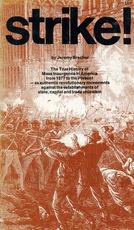
Strike!
The True History of Mass Insurgence from 1877 to the Present
Brecher, Jeremy
Publisher: Straight Arrow Books, San Francisco, USA
Year First Published: 1972
Year Published: 1997
Pages: 329pp ISBN: 0-89608-569-4
Dewey: 331.892
Resource Type: Book
Cx Number: CX6590
A history-from-below that brings to light strikes as authentic revolutionary movements against the establishments of state, capital, and trade unionism.
Abstract:
Brecher writes: The mains actors in the story are ordinary working people. Most historians, whether radical or conservative, tend to consider ordindary workers a mere "rank and file," controlled and directed by unions and labor leaders. Strikes are presumably the work of these organizations and leaders. I have found, on the contrary, that far from fomenting strikes and rebellions, unions and labor leaders have most often striven to prevent or contain them, while the drive to extend them has generally come from a most undocile "rank and file." Indeed, the most important lessons I learned in preparing this book is the extent to which ordinary working people, acting on their own, have through the decades thought, planned, drawn lessons from their own experiences, organized themselves, and taken action in common. Much of the time these abilities have had no chance for expression; they were suppressed in a society which believed ordindary working people should distrust one another and obey their superiors. But when "looking out for number one" and "getting along by going along" no longer worked, people discovered that together they had powers they never suspected.
This is important because the greatest problem we face today is our powerlessness. It underlies every particular problem we face: war, pollution, racism, brutality, injustice, insecurity, and the feeling of being trapped, our lives wasting away, pushed around by forces beyond our control. The source of all these problems is not some cruel decree of fate; every one of them results from the fact that we do not control the life or our own society. The fundamental problem we face -- and the key to solving the more particular problems -- is to transform society so that ordinary people control it.
Table of Contents:
Preface
Part I: The History of American Strikes
Prologue
Chapter 1: The Great Upheaval
Chapter 2: May Day
Chapter 3: "The Ragged Edge of Anarchy"
Chapter 4: Nineteen Nineteen
Chapter 5: Depression Decade
"Don't Starve - Fight"
Nineteen Thirty Four
Sitdown
Chapter 6: Postscript the War and Post-war Strike Wave
Part II: The Significance of American Strikes
Chapter 7: The Significance of Mass Strikes
The Mass Strike Process
The Course of Mass Strikes
The Containment of Mass Strikes
Chapter 8: The Current Scene
Chapter 9: From Mass Strike to New Society
Afterword: A Challenge to Historians
Subject Headings


